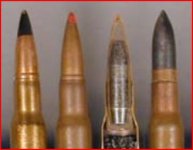flat top
Member
- Joined
- Dec 4, 2008
- Messages
- 491
- Reaction score
- 9
SC; The reason for the modification to my die as stated in the first post, was to keep the Lee Factory Crimp Die sizing insert (in the bottom of the die) from sizing down the over bore sized cast bullets that I shoot in my guns. The "crimp" is a seperate issue. As I said in a previous post, .429, or even .430 bullets did not cause a problem in my die, and I am sure they do not cause a problem in yours. Its when I use bullets that are sized larger than .430 (and all of mine are), that the issue arises. The sizing insert in my die would actually size the larger bullets down as the cartridge entered the die...therefore they would not shoot accurately in my guns, because they were undersized (although they didnt start off that way!). I only offered up this remedy for anyone else who may have been having that problem. An easy way to determine this is to seat the bullet in the case and mic the diameter of the case above the bullet seating depth. Then run the bullet into the Lee Crimp Die, remove, and mic the case in the same spot. There should be no reduction in the measurement............Anyway, your crimps (an entirley different subject), look ideal. If they work for you the same way they work for all of the folks that use the Lee Crimper in this manner, I think that you will be very satisfied with the results. Again, as I stated before, you may need to adjust your loads a bit to gain optimum performance and accuracy after changing to this type of crimp. If you choose to continue useing the crimp, I think that you will find, as I have, that your cases will last just as long with the Lee heavy crimp as they did before.





